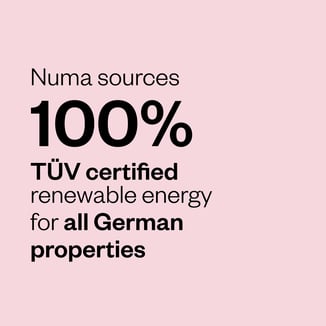Do you know what the carbon footprint of an average (and let's be honest, old school) night at a hotel is? Yeah, neither did we until we started writing this article. 🙈
The Carbon Impact of Traditional Hotels
But in all seriousness, let's take a look at the numbers. The average carbon footprint of a single night at a traditional hotel is around 40 kg CO2—the equivalent to driving 142 km in an average petrol car1–which is the kind of statistic that really sticks with you. Of that amount, on average, around 70% of the carbon footprint of a hotel stay comes from energy usage.2 And that makes sense, because at a traditional hotel, you often find heated pools, gym facilities, and other common areas that don’t see much use but can be real power hogs and drive up energy consumption. 🐷🔌
You might remember from our last article that we love doing more with less, and that’s true here too. We know you want the perfect home away from home when you're visiting a new city, and you’re probably more interested in exploring local hidden gems than spending all your time at the hotel. At numa, we cut out wasteful amenities (think disposable slippers, single-use cups, tiny plastic shampoo bottles) to ensure we give you the best quality of what you really want.
So when we started developing ways to reduce the impact of our stays, we knew we were off to a good start, but we also knew we wanted to source lower-emission energy for everything that powers a great stay.
Taking a Greener Approach: How numa is Collaborating for The Best Energy Strategy

numa already sources 100% TÜV certified renewable energy for all of our German locations which we contract ourselves–and that's just the start. You’ve probably heard the saying that “two heads are better than one” and we like to think that’s kind of how partnerships work. We’re the experts in hospitality and tech, but we knew that if we wanted to find the best options for sourcing renewable energy for our stays, we should defer to an expert there—and we found several!
numa stays can be found all across Europe and each country’s energy market is different, so we’ve been working with partners and service providers in each country who specialise in their region. These collaborations ensure that we work smarter (not harder), leveraging local expertise to tailor our sustainable energy mix to each region's unique energy landscape, with the highest possible share of renewable energy.
Carbon Neutral Natural Gas: Minimising the toughest emissions
You may have noticed that last sentence mentioning 'energy mix' and not quite understood what it meant. Well, it can often be difficult to get all your electricity, even for your own home, from completely renewable sources. Natural gas, for example, accounts for about 22% of the world's electricity3 and is also widely used across Europe for heating water and homes and businesses themselves. This means that while we are trying to get as much energy as possible from renewable sources, we sometimes have to use natural gas for things like hot water because of infrastructure or existing design. So if natural gas causes emissions that we can't avoid, how do we make sure we minimise its impact?
While it’s not a perfect option, carbon neutral natural gas plays a crucial role in supporting our sustainability objectives, offering a bridge to cleaner energy practices. So what is carbon neutral natural gas? Well, “carbon neutral” just means that the emissions produced by using natural gas for parts of our stays, like for heating, are balanced by verified carbon offset projects.4 This approach is a key part in our strategy for operations where gas is essential but we are still determined to minimise our impact, contributing to a more sustainable and balanced energy portfolio. By incorporating this innovative solution, we're pushing the boundaries of what's possible in striving for better environmental responsibility.
Starting Small But Thinking Big
Good things take time, and finding the right partners for developing our sustainability initiatives is no different. We’re dedicated to forming partnerships with organisations that have the right knowledge to help us make the most out of the “E” in our ESG journey. So while starting small with lower impact energy sourcing might not be the sexiest thing, you can rest easy at numa stays knowing your stay is taking it a little easier on the planet. 🧩🛌
Sources:
- Staze (2023), Why does staying in a hotel have a carbon footprint?, available from https://staze.com/blog/why-does-staying-in-a-hotel-have-a-carbon-footprint/
- Staze (2023), Why does staying in a hotel have a carbon footprint?, available from https://staze.com/blog/why-does-staying-in-a-hotel-have-a-carbon-footprint/
- MIT Technology Review (2020), Zero-Carbon Natural Gas, available from https://www.technologyreview.com/technology/zero-carbon-natural-gas/
- Ernst & Young (2021), The role of carbon neutral LNG in the energy transition, available from https://www.ey.com/en_pl/law/the-role-of-carbon-neutral-lng-in-the-energy-transition